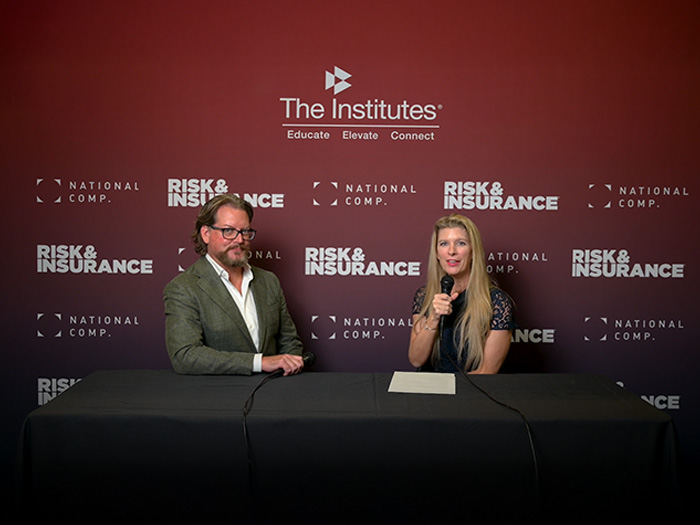Survey Results: Faith in How Technology Can Help Workers’ Comp Pros Address Today’s 10 Most Pressing Challenges

The results of the seventh Risk & Insurance survey of workers’ compensation professionals, sponsored by Healthesystems, are in and this year industry stakeholders were clear: advanced technologies continue to gain increasing prominence in the industry.
Organizations are embracing advanced analytics, machine learning and artificial intelligence tools. More than 62% of survey respondents said they believe these tools will aid in identifying workers’ comp fraud and another 53.54% said they will be helpful in managing and summarizing medical notes.
Many are also optimistic that new tech tools will help address many of the industry’s other more pressing challenges.
This year, 515 industry professionals responded to the survey. It was conducted between October 15-17 at the National Comp conference in Las Vegas and online for a period of time afterwards. Here are the top ten concerns survey respondents identified.
1) Workers’ Comp Litigation
Coming in as the number one concern: workers’ comp litigation. Sixty-one percent of survey respondents listed it as their top concern. That’s up from 47% who cited it as a pressing challenge in 2023.
Litigation is likely top-of-mind because of the rising costs of defense and the high costs of jury verdicts in recent years. Many workers’ comp professionals are concerned about litigation and are trying to implement programs to help reduce the risk of a claim going to court.
2) Health Care Provider Shortages
Last year, health care provider shortages were the number one concern for workers’ comp professionals. Now, that issue has been knocked down to the number two slot. The U.S. is expected to be short 64,000 physicians by the end of this year, per a McKinsey report.
More than 58% of survey takers named health care provider and service shortages as a number one challenge.
The issues driving this concern are similar to last year: retirements and burnout are causing a number of professionals to leave medical specialties; there are too few medical students to fill these gaps. Rural hospitals, especially, struggle to find staff and suffer from a dearth of medical specialists in many disciplines.
3) Comorbidities and Social Determinants of Health
Poor worker health is steadily becoming more concerning to survey-takers. In 2022 and 2023, it was the number six concern. Now, it’s number three. It nearly tied with health care provider shortages for the number two slot — 58.42% for medical workforce shortages; 58.21% for poor health.
Comorbidities, like diabetes or heart disease, can make treating an injured worker more complicated. More than 51% of U.S. adults suffer from one or more chronic conditions, per CDC data from 2018. Nearly 30% have multiple conditions.
4) Mental Health Conditions and Coverage
Mental health conditions and coverage, which first made the list of top challenges last year, remains a pressing concern for industry stakeholders. The topic ranked number three in 2023, this year it’s listed at number four. In recent years, many workers’ compensation programs have embraced whole person care models that try to address any mental health issues that could derail claims. This would include PTSD claims on the part of first responders, which many state legislators and payers are attempting to address.
More than 53% of survey takers list mental health conditions and coverage amongst their top concerns. When asked about the biggest barriers to injured worker recovery 43.49% said they worried about mental health conditions.
5) Price Inflation
Medical and pharmaceutical price inflation came in fifth, with 50.94% of survey respondents listing it among their top challenges. Inflation is hitting every part of the economy and, though it’s abating somewhat, it’s natural for payers and other stakeholders in the workers’ compensation system to be concerned about it. Inflation rose from the number eight concern in last year’s survey to number five this year.
These concerns are reflected in their broader priorities for their medical management program. The number of respondents who named the use of network providers as a major priority for their medical management program increased more than 13% from 30% in 2023 to 43.33% in 2024.
On the pharmaceutical side, 39.03% said decreasing the usage of expensive, private label topical drugs is a priority this year. Only 17.19% listed it as a priority last year.
6) Complex Claims
More than 50% of survey respondents ranked complex claims as a major concern. Complex claims as a concern are in one way related to challenges like price inflation, litigation, fraud, waste and abuse, which although they have different origins, fall into the bucket of loss or cost controls.
The longer and more difficult a claim is, the more likely a worker is to disengage with the recovery process. More than 58% of survey participants say disengagement and unfamiliarity with the workers’ comp system is a barrier to recovery.
7) Staff Recruitment and Retention
Health care isn’t the only field facing talent shortages. Workers’ comp, and the broader insurance industry, have been facing staffing challenges over the past few years, though these issues seem to be abating somewhat. Last year, survey participants ranked the talent crisis as their number four concern. This year, with 47.40% of the vote, it’s fallen to number seven.
A heavy focus on recruitment and retention, expanded benefits programs and a renewed focus on internships and education is likely helping to increase the number of people in the insurance workforce.
8) Workplace Safety Challenges
Workplace safety challenges, long a pressing concern, have slipped from the number two challenge last year to number eight this year. Close to 44% of survey participants listed workplace safety challenges as a major issue.
The sting of economic concerns and labor challenges have workers’ comp pros focused on finances. Readers shouldn’t necessarily interpret the fall in the ranking as a lack of focus on workplace safety culture. Companies have long implemented safety programs and now may feel comfortable reaping the benefits of the initiatives they’ve already put into place.
9) New Regulations
Workers’ comp has long been beleaguered by regulatory inconsistencies and enforcement pressure. Each state has its own system and laws are always changing, so employers in multiple states have a lot to keep up with.
Of survey respondents, 41.16% said new regulation and/or expanding coverage requirements are a major issue. In 2023, increasing regulatory demands ranked number nine, with 30.9% naming it a top challenge.
10) Operational and Technological Inefficiencies
Improvements in operational efficiency in the industry overall have caused the topic to drop way down the list of top concerns. This year, like last, it ranks number ten on the list of challenges workers’ comp pros are concerned about. Only 34.51% of survey respondents ranked it amongst their top concerns.
Though it has fallen in the rankings, it makes sense that operations remains consistent as a concern and hasn’t fallen out of the top ten: smooth operations reduce claims costs and improve the experience for injured workers and adjusters alike. It would behoove carriers and claims administers to keep operational efficiency as a priority.
Key Takeaways
Although many of the challenges workers’ comp professionals reported facing in 2024 can in part be addressed by emerging technologies, we shouldn’t forget that soft skills, such as empathy from providers and payers, will always play an important role. That being said, industry leaders are increasingly confident that claims process automation, machine learning, predictive analytics and telemedicine can all help address issues like talent shortages, a lack of access to medical care and complex claims.
When asked what technologies they thought would play an important role in their medical management programs in the near future, the number one choice from survey respondents was claims process automation, with 59.62% percent of respondents listing it as a top tool and approach. Following it were telemedicine (50.23%), mobile apps (43.66%) and predictive analytics (41.55%).
For many, improving the claims process and increasing operational efficiency is the most beneficial initiative for improving medical management programs. More than 55% of respondents named increasing operational efficiency as the most beneficial strategic program they’ve implemented over the past two to three years. Following improved operational efficiency was building strategic relationships with partners and providers.
Throughout the thread of survey responses beats the pulse of workers’ compensation’s higher purpose. It is to get injured workers back to leading a productive life that gives them meaning and purpose. We should never forget that the tools we invest in should serve that goal first and foremost. &
Readers who would like to receive a copy of the full survey report when published in February can request a complimentary digital copy from Healthesystems.










